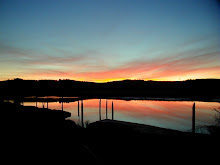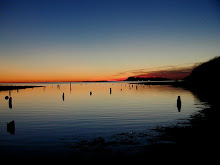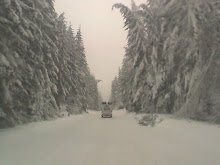So your looking at this funky machine and this site aspires to natural history and your wondering what the hell is so natural about this! Well that is the point and time will reveal the nature of this history. This weird vehicle represents just a tiny bit of the heavy artillery employed in the War..an ecological war of wars yet to unfold. Dave Milne, my co-conspirator and often partner in ideas, and I hauled this sucker down from Taylor United's Bellingham ops via the Keystone-PT ferry and then, after fooling around with it for a few years, we hauled to WSU Pullman so it could enter a 3rd life as a test bed for other aquaculture uses. We got some interesting looks on the freeway.
 Back in 2001, Dave and I spent some serious time looking at how Spartina could be crushed into oblivion. One of our favorite mud vehicles was the 4450 Rolligon. It worked pretty well as long as it was running (hydraulics, flat tires, etc). We did these tests on a thin dime but learned quite a bit as to the amount of force that it would take to crush the root structure. The idea came from Jack Wiegardt's experiences with a big Oliver tractor and that repeat driving over the root structure of the plant killed it. Doing this on a agricultural scale (as in thousands of acres) was possible but it required an application of terrestrial ag systems to an estuary and that is no mean feat. Most soft mud substrates can only be traversed by vehicles (other than an air boat)with .5 psi ground loading and that is serious low pressure tires/tracks, etc. and typically what a sno-cat can produce. And just because you can drive out there doesn't mean you can pull anything. Mud shears pretty easily thus tractive power, that is power to pull something, is limited by the wheel or tracks ability to grab ground and move ahead. After stewing about this and observing the USFWS's Quality Machine tracks in Pot Shot Slough, I ended up concluding that the vehicle's tracks or wheels/tires would be the easiest way to get ground penetration. Ed Erola (Chinook boat builder extraordinaire...I think he's about retired) and I came up with a large wheeled vehicles whose steel wheels were the "implement".
Back in 2001, Dave and I spent some serious time looking at how Spartina could be crushed into oblivion. One of our favorite mud vehicles was the 4450 Rolligon. It worked pretty well as long as it was running (hydraulics, flat tires, etc). We did these tests on a thin dime but learned quite a bit as to the amount of force that it would take to crush the root structure. The idea came from Jack Wiegardt's experiences with a big Oliver tractor and that repeat driving over the root structure of the plant killed it. Doing this on a agricultural scale (as in thousands of acres) was possible but it required an application of terrestrial ag systems to an estuary and that is no mean feat. Most soft mud substrates can only be traversed by vehicles (other than an air boat)with .5 psi ground loading and that is serious low pressure tires/tracks, etc. and typically what a sno-cat can produce. And just because you can drive out there doesn't mean you can pull anything. Mud shears pretty easily thus tractive power, that is power to pull something, is limited by the wheel or tracks ability to grab ground and move ahead. After stewing about this and observing the USFWS's Quality Machine tracks in Pot Shot Slough, I ended up concluding that the vehicle's tracks or wheels/tires would be the easiest way to get ground penetration. Ed Erola (Chinook boat builder extraordinaire...I think he's about retired) and I came up with a large wheeled vehicles whose steel wheels were the "implement".  Years later I came across this unusual vehicle designed to chug through exotic weed infested wetlands and it wasn't to much different from what Ed and I sketched out. To make it really interesting I concluded that it should be built of wood and burn Spartina to power a steam engine.
Years later I came across this unusual vehicle designed to chug through exotic weed infested wetlands and it wasn't to much different from what Ed and I sketched out. To make it really interesting I concluded that it should be built of wood and burn Spartina to power a steam engine.

This roller [Sayce I] was made from an old sheet press, which was nothing more than a 1/2 inch shell mill roller about 10 feet long and weighing a ton+ It was big and heavy but in the end it had too much flotation. That is an example when size mattered and in this case, it was to large as it could not generate the proper amount of down force, even though it could "knockdown" the plant, it was not adequately crushing the root structure. Live and learn.
 This is the Heckes-Sayce I roller. I got this on permanent loan from John Heckes and then Dave and proceeded to destroy it towing it across the mud flats testing it up in Oysterville. What made it work well was that it was narrow and had big angle iron flanges that penetrated into the mud. The tow rig was weak and the water tank that formed the core structure was weaker. When filled with water it was heavy, narrow and had all the right stuff to get to the Spartina root structure and it worked well till it hit a few stumps, piling, and just plain leaked and fell apart. I should have filled it with concrete.
This is the Heckes-Sayce I roller. I got this on permanent loan from John Heckes and then Dave and proceeded to destroy it towing it across the mud flats testing it up in Oysterville. What made it work well was that it was narrow and had big angle iron flanges that penetrated into the mud. The tow rig was weak and the water tank that formed the core structure was weaker. When filled with water it was heavy, narrow and had all the right stuff to get to the Spartina root structure and it worked well till it hit a few stumps, piling, and just plain leaked and fell apart. I should have filled it with concrete.
I finally concluded that you had the ability to tow/pull and implement (an open question), then then a "Yap Wheel Gang Roller" might be the set up. At some point I was going to hunt up an old Sheep Foot roller (typically towed by a big cat, say a D-6 +) and try that out in the next stage of evolution as that type of roller was bascially two narrow water filled rollers with compressive "feet" (hence the name a "Sheep's Foot" roller). One point is that the root structure may have needed to be cut more than crushed, thus a penetrating disc might work just as well. Dave and I never got that far into our tests to experiment with cutting vs. crushing the roots.











No comments:
Post a Comment